The Mundrabilla Meteor
A series of catastrophes has brought each of us to our present state. The calcium and iron atoms
Robert Kirschner, Harvard astrophysicist.
that form our bones and blood were forged in the crucible of stellar catastrophes
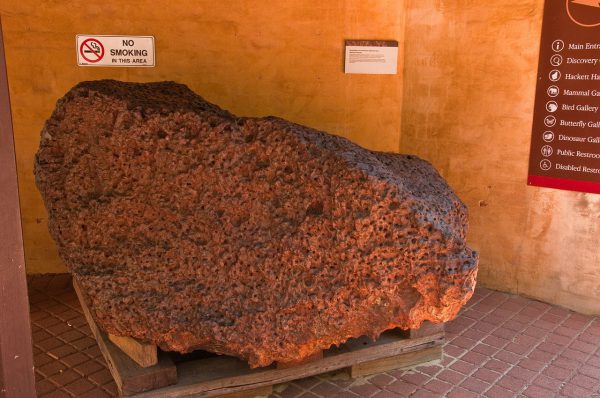
A significant exhibit in the Perth Observatory Museum is the Mundrabilla meteorite. Discovered in 1983, the 189 kg fragment is one of many making up over 22 tonnes recovered in the Mundrabilla region of Western Australia. Remote, sparsely populated and not easily accessible, Mundrabilla is a 6,000 km² chunk of the Nullarbor desert near the WA/SA state line, bordering the Great Australian Bight. It’s 1,162 km from Perth and 67 km west of Eucla.
Based upon analysis done in 1973 by the Max Plank Institute for Nuclear Physics in Heidelberg, Germany, the impact from the Mundrabilla meteorite is estimated to be 1,000,000 years old, and cosmic ray exposure indicates the meteorite broke off from a larger asteroid mass around 200 million years ago. Two smaller meteorite falls, Loongana Station and Premier Downs, are known to be from the same pre-atmospheric mass – due to their identical, and unusual, mineral composition. All three finds were within 60 km of each other.
The story and discovery of the Mundrabilla meteorite, like the object itself, is fragmented and scattered. The word, ‘Mundrabilla’, is derived from Mondra Bellae, the name given their sheep station by William Stuart McGill and brothers Thomas and William Kennedy in 1872. Today, the region of Mundrabilla has a population of 23 and includes a roadhouse and a motel. The first small fragment of the meteorite was discovered in 1911, and two more several years later, each weighing around 100 g. Following this inauspicious start and decades of rumours, in 1966 two masses of 12.4 and 5.44 tonnes were found 183 m apart and named Mundrabilla 1 and Mundrabilla 2 respectively.
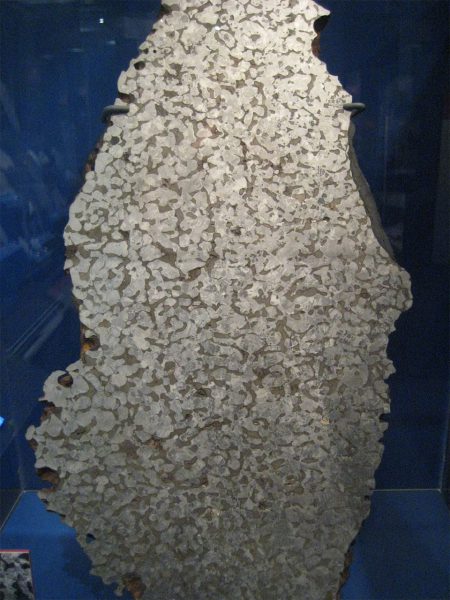
M1, the main mass of 12.4 tonnes, is now in the external courtyard of Boola Bardip – the newly opened WA Museum in Perth, so can be seen and touched without entering the museum. A slice and two fragments are in the museum’s Origins gallery on level two of Boola Bardip. M2 was cut in half, one 2.5 tonne piece put on display in the Adelaide Museum, the rest sliced, some for analysis by the Max Planck Institute, others displayed in the Natural History Museum in London, the Smithsonian Museum of Natural History in Washington DC, and the WA and SA Museums. Records of the exact weights of M1 and M2 vary depending upon the source, but they generally weigh between 10 and 12.4 tonnes (M1) and five to six tonnes (M2).
In 1979, a further two fragments weighing 840kg (M3) and 800kg (M4) were found 20 km from the M1/M2 discovery site; they’re now housed in Boola Bardip. Perth Observatory’s fragment was found in 1983 and although separate, it’s considered to be part of M1. The Gravity Discovery Centre in Gingin has a 300 kg fragment on display, and the Albany Museum (part of WA Museum) houses a 3.5-tonne fragment, found in 1988.
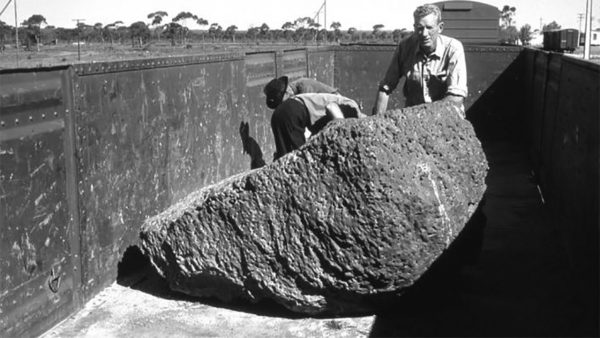
A total mass of over 22 tonnes recovered makes Mundrabilla the largest meteorite found in Australia, and the eighth largest in the world. Based upon this weight and a measured density of 7.56g/m³ the meteorite has a calculated volume of around 3 m³. The Max Planck Institute estimated its pre-atmospheric weight at 50 tonnes and based upon a calculated amount of ablation (loss of mass from contact with the air molecules in the atmosphere), its original volume would have been over 6m³.
The world’s largest meteorite is the 60-tonne iron Hoba Meteorite, discovered in Namibia in 1920. Hoba has a volume of just over 7 m³. A 45 kg slice of M2, held by the Smithsonian, was lent to NASA for CT analysis in 2002, to help understand alloy formation. Mundrabilla has both iron-nickel and iron sulphide that formed within a low gravity environment over billions of years. Low-temperature superconductivity was also found in M1 in March 2018. This alloy of iridium, tin and possibly lead is evidence of an effective means of searching for naturally occurring superconductors.
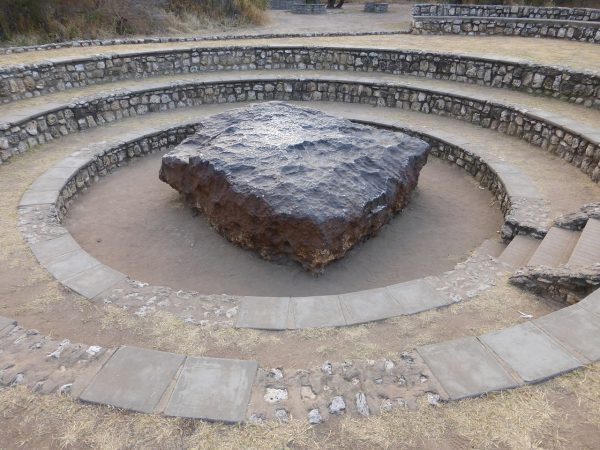
Mundrabilla is classified as an ‘iron’ meteorite, made mostly from iron and nickel and is the commonest kind recovered on earth, but the least common flying through space. ‘Stones’ are the most common meteoroids travelling in space; however, they’re less commonly recovered on earth for several reasons. The weather more, are more likely to fragment on impact with Earth’s atmosphere, and they’re harder to distinguish from terrestrial rocks after landing. Stony irons are the least common, and while the names are descriptive, almost all contain some iron. Such is the irony of meteorite composition and classification.
‘Irons’ comes from the core of larger asteroids, understood to result from their molten stages where the denser iron sank to the centre, like the process of planet formation. Meteorites are further categorised based upon more specific types and sub-types based upon chemistry, structure, and specific minerals. More rarely, some meteorites originate from Mars and our Moon.
The Murchison meteorite, seen falling in 1969 and recovered in Murchison, Victoria, has been dated back 7 billion years
The Murchison meteorite seen to fall in 1969 and recovered in Murchison, Victoria, has been dated back 7 billion years. That’s around 2.5 billion older than the Earth and solar system. While the Mundrabilla meteorite is impressive, it’s just a small chip off the block. Collisions and impacts have been common in the history of our solar system and presumably other planetary systems throughout the universe. The cratered face of the Moon is a testament to this ongoing bombardment, and a combination of minimal erosion and no tectonic movement has preserved the scars on the Moon.
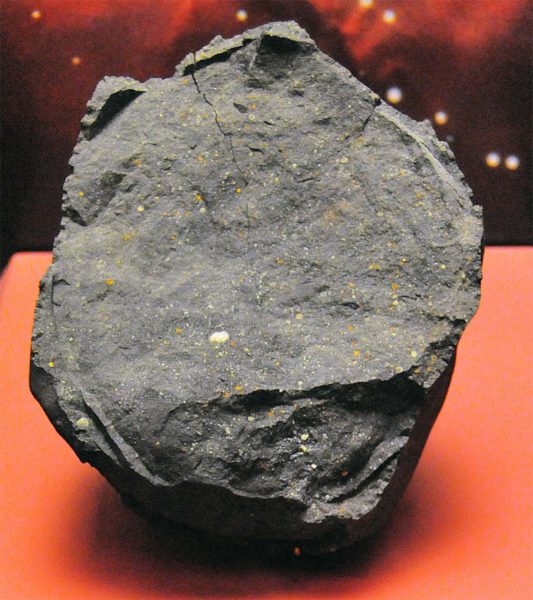
In contrast, on Earth, our more active surface of the water and atmospheric erosion, as well as tectonic activity, has greatly reduced the evidence of strikes. There have been five extinction events that we know of in the past 500 million years since the Cambrian explosion of diverse and complex life forms. Only the Cretaceous–Paleogene extinction event (formerly Cretaceous-Tertiary) 66 mya is thought to have been caused by an asteroid impact.
An object between 10-80 km across and weighing tens of billions of tonnes, struck the Yucatan Peninsula near the present-day town of Chicxulub, leaving a crater 200km across. The impact almost certainly wiped out deep-sea ammonites and all but some avian dinosaurs, 75% of all species, creating an ecological niche for mammals. The Chicxulub asteroid hit the earth at 20-30 km/second and generated energy equivalent to ten billion of the atom bomb dropped on Hiroshima, Japan, in 1945.
Yucatan had been covered in a layer of limestone that was converted into carbon dioxide from the Chicxulub impact, a tsunami one kilometre high raced across the Gulf of Mexico, oxygen was consumed in the aftermath of fires and fragments of the planet and asteroid rained down on Earth. The devastation was on an unimaginable scale, and the long-term effects caused major extinctions and transformed the planet. The history of discovery and drama of this has been described by Walter Alvarez in his 1995 book, T. Rex and the Crater of Doom
In 1984, a meteorite weighing half a kilo fell a few metres from two women tanning on Binningup beach, WA
In the more recent past, notable events include a meteorite that exploded above Tunguska, Siberia, in 1908, flattening trees for thousands of square kilometres. Between 50-200 metres in size, the explosion from the Tunguska Event was around a thousand times more powerful than the bomb dropped on Hiroshima in World War II.
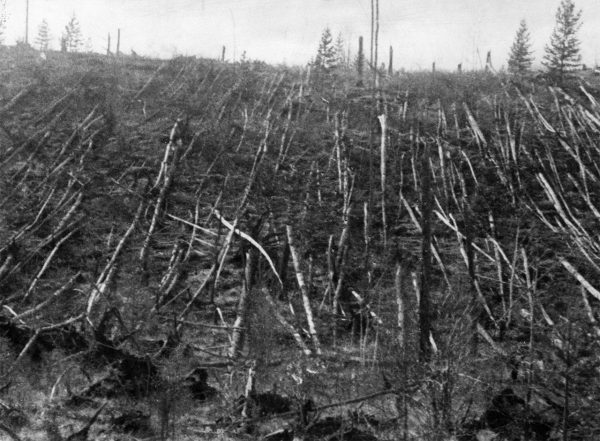
In February 2013, a 20 m body exploded above the Russian town of Chelyabinsk, releasing energy 30 times that of the Hiroshima bomb, injuring 1,500 people, mostly from flying glass shattered by the resulting shock wave. And, in 1984, a meteorite weighing half a kilo fell a few metres from two women tanning on Binningup beach in WA.
One phenomenon associated with exceptionally large and specific meteorite impact craters are tektites, molten blobs of glassy material created by instantaneously splattering molten rock. Tektites are widely scattered and even ejected from the atmosphere. Across the world, there are just four tektite strewn fields that we know of (including one from Chicxulub), each with specific ages, distribution types and distinctive shapes.
Some tektites produce unusual phenomena. Homes in Nördlingen, Germany contain countless tiny diamonds. When a meteorite smashed into a local graphite deposit, the impact created thousands of tonnes of diamonds and stone from the area was quarried and used to build homes.
According to the American Meteor Society, meteoroids and comets enter the Earth’s atmosphere at speeds ranging from 11 to 72 km/s (40,000-250,000km/h). Slowed by our atmosphere, objects under seven tonnes lose all cosmic velocity and hit the ground at gravitational speeds of between 300 and 600 km/h. The impact effect is also affected by the angle travelled as the meteoroid intersects with Earth.
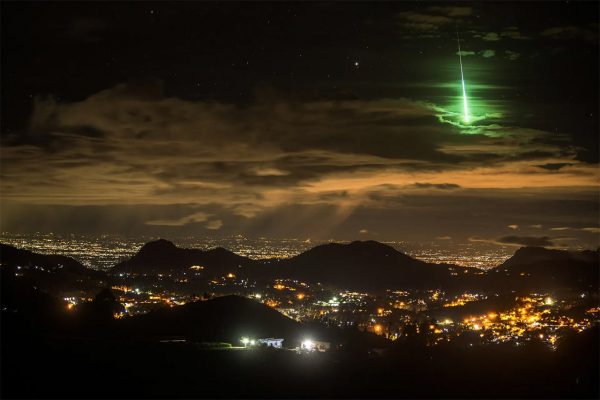
Masses over seven tonnes retain some of their cosmic velocity, at 1,000 tonnes most is retained, and objects over 100,000 tons are not slowed at all by the atmosphere. Mundrabilla’s pre-atmospheric mass is estimated to be 50 tonnes, meaning a small amount of cosmic velocity should have been retained; however, no impact crater exists – so its contact speed must have been close to gravitational velocity.
Spend some time with the Mundrabilla meteorite, feel its surface texture, its dense massiveness – and imagine the scenario one million years ago on the barren Nullarbor, much the same as it is today. You’re touching an interstellar traveller, written with the history of our solar system. The Mundrabilla meteorite presents as a rusted mass of stone and iron, yet it’s an extraordinary fragment from an extraordinary past.
As for me, I am tormented with an everlasting itch for things remote. I love to sail forbidden seas, and land on barbarous coasts
Herman Melville





